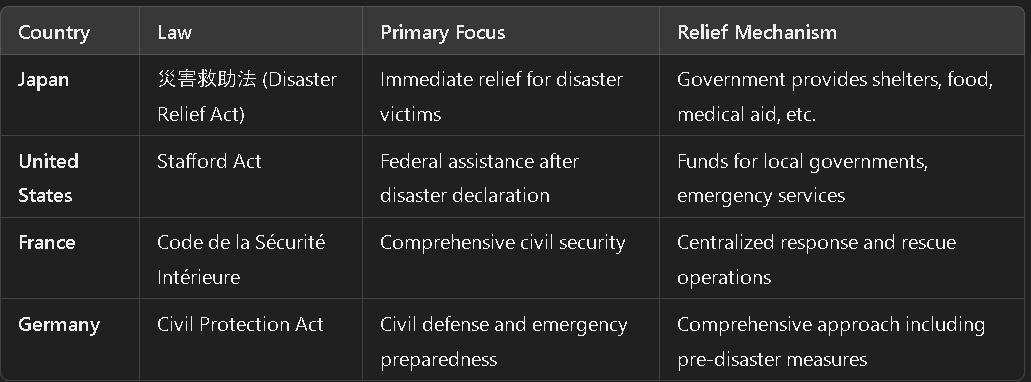
災害救助法1/Disaster Relief Act1
#災害 #law #日本 #Japan #Chibil #AI
Japan’s Disaster Relief Act (災害救助法), enacted in 1947, remains a cornerstone of Japan’s disaster management strategy. As recent disasters like Typhoon No. 6 and the Noto Peninsula earthquake in 2024 illustrate, the law is frequently updated and applied to meet evolving challenges, especially in the face of climate change and technological advancement.
Base Analysis of Japan’s 災害救助法 (Disaster Relief Act)
1. Legal Classification
Type: Administrative law.
Purpose: To provide rapid and organized relief during natural disasters.
Recent Updates: Modern updates include enhancements for government coordination with international organizations and non-governmental entities during large-scale disasters.
2. Historical Context
Original Law (1947): Developed post-World War II to deal with frequent natural disasters in Japan.
Modern Developments: Following major events like the 2011 Great East Japan Earthquake, the law was updated to ensure a more robust and technologically integrated response.
3. Implementation and Impact
Key Provisions:
Guarantees access to essential relief services (shelter, food, medical aid).
Gives local governors authority to manage relief efforts and requisition property as needed.
Recent Relief Efforts: The Act was pivotal during the 2023-2024 typhoon and earthquake responses, facilitating rapid deployment of shelters and emergency medical services.
Global Comparison: Similar Laws in Other Countries
1. United States: The Stafford Act
Similarities:
Both the Stafford Act and Japan’s Disaster Relief Act coordinate federal and local disaster response.
Both laws empower local authorities to request national intervention when necessary.
Differences:
The U.S. model requires state governors to request federal assistance, whereas Japan gives its local governors more direct emergency powers.
2. France: Code de la Sécurité Intérieure
Similarities:
Both France’s and Japan’s laws prioritize immediate relief and national coordination.
Differences:
France’s laws emphasize broader national security in addition to disaster response, while Japan’s Act is more narrowly focused on post-disaster recovery.
Types of Disaster Relief Laws

Trends in Disaster Relief Legislation
1. Integration of Climate Change
Global Shift: With increasing disaster risks linked to climate change, Japan is updating its laws to focus on climate resilience and sustainable recovery.
International Cooperation: Japan’s alignment with global disaster frameworks, such as the Sendai Framework for Disaster Risk Reduction, ensures it remains at the forefront of international disaster relief efforts.
2. Digitalization of Relief Efforts
Technological Advancements: Both Japan and other nations are now utilizing AI, mobile applications, and digital tools for real-time disaster response and early warnings.
Advice for Foreigners Navigating 災害救助法
1. Understanding Emergency Protocols
Familiarize yourself with Japan’s emergency hotlines and local evacuation procedures. Disaster alerts are available in multiple languages through apps like NHK World.
2. Access to Relief
Under Japan’s Disaster Relief Act, all residents, including foreigners, are entitled to government aid during disasters. Make sure to follow official instructions for accessing shelters and other resources【12】.
3. Community Participation
Join local disaster drills and stay informed through local government channels for specific guidelines on disaster preparedness.
Conclusion
Japan’s Disaster Relief Act remains a highly effective legal tool, ensuring that the country can respond rapidly to natural disasters. With its integration of climate adaptation and advanced technologies, Japan’s legal framework provides a model for global disaster management efforts.
References
Ministry of Internal Affairs and Communications, Japan
This resource provides details on how the Disaster Relief Act is applied in real-time disaster situations, such as typhoons and earthquakes.
https://www.bousai.go.jpJapanese Law Translation, Disaster Relief Act
Offers a full translation of the Disaster Relief Act in English, along with explanations of the law’s key provisions and its recent updates.
https://www.japaneselawtranslation.go.jpClimate Change Laws of the World, Disaster Relief Act (Law no. 108)
Provides insights into how Japan’s Disaster Relief Act intersects with climate policy and disaster risk reduction strategies.
https://climate-laws.org/geographies/japan/laws/disaster-relief-act-law-no-108
いいなと思ったら応援しよう!

